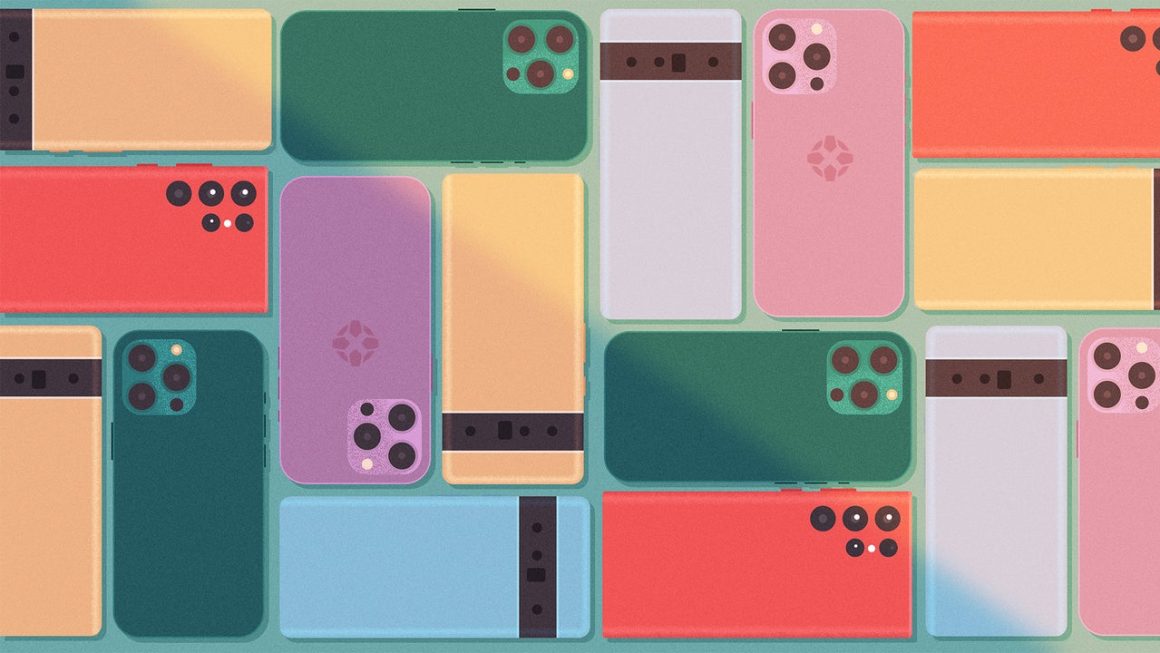Smartphones aren’t exactly the most exciting gadgets to splash out on. Glass rectangles that most people use to message their friends, watch YouTube videos, scroll social media, and snap photos – they might be essential for day-to-day living, but cost a pretty penny if you want the latest and greatest. That’s why we’ve picked out the best smartphones to buy by seriously weighing the value against price.
TL;DR – These Are the Best Smartphones:
Of course, what everyone finds valuable is different. Some people will want excellent photo quality from their phone. Others will want to get extreme performance for gaming on the go. If you watch a lot of TV and movies on your phone, it’s natural to look for a phone with a stunning display. Fortunately, we’ve tested phones that cover all the bases.
Here, you’ll find phones that let you do a bit of everything, from the best Android phones and iPhone alternatives to the latest and greatest from Apple. Some may prioritize certain aspects over others, but you won’t find a phone that’s practical garbage or one that makes too many sacrifices just to hit a low price. You also won’t be looking at just the newest phones. Every now and then, the advantage an older model has from price reductions makes it all the more valuable, helping it to undercut newer alternatives. So, keeping in mind what you want out of a phone, have a look at the best options across the market.
Contributions by Jacqueline Thomas, Callum Bains, and Danielle Abraham
1. OnePlus 13
Best Smartphone
Screen
6.82-inch OLED, 1440×3168, 510ppi, 120Hz refresh rate
Processor
Snapdragon 8 Elite
Camera
50-Megapixel Wide, 50-Megapixel Ultrawide, 50-Megapixel Telephoto, 32-Megapixel Seflie
Software support a little shorter than rivals
Samsung makes some of the best smartphones, and while I can’t deny that the Samsung Galaxy S25 Ultra is a great phone, it’s also just a little too boring this year to stand out, especially when it sells at such a premium price. Between that and OnePlus truly hitting its stride this year, the OnePlus 13 lands a huge victory in 2025. It delivers on design, performance, and value for a trifecta that helps it stand above the crowd.
On the face of the OnePlus 13, you’ll find a display that’s ready to rival the best around. The 6.82-inch OLED display offers everything you’d expect from a high-end phone: a sharp resolution, a fast and variable refresh rate, and a staggering peak brightness, which OnePlus claims hits 4,500 nits. While I couldn’t verify the exact degree of brightness, I can confirm it’s a gorgeous and dazzling display that doesn’t struggle with visibility.
Inside, the OnePlus 13 makes the most of the Snapdragon 8 Elite chipset. This comes with a powerful CPU and GPU combo that rivals the best iPhones and runs circles around them in 3DMarks’ graphics benchmarks. Whether it’s everyday performance or gaming brawn, the OnePlus 13 has it in heaps. Plus, the phone comes with 256GB of storage as a baseline, providing plenty of room for games and apps, and the 6,000mAh battery helps the phone run longer.
Circle around back, and you’ll find a triple-camera array. Each sensor offers a 50MP resolution for clear details. The sensors work together wonderfully, offering great colors, tons of flexibility, and even powerful video capture. The OnePlus 13 may not be quite as adept at zooming in, since it relies on a 3x telephoto sensor instead of the 5x you’d find in the iPhone 16 Pro, Pixel 9 Pro, or Galaxy S25 Ultra. But in just about every other aspect of photography, the OnePlus 13 is competitive with these other flagship phones.
All of this quality is packed into a phone that looks and feels great. OnePlus offers a few different styles, going beyond just changing colors and actually swapping out materials and textures. The exterior protects the guts of the phone with robust ingress protection that can keep out water when submerged or hit with pressurized jets.
Getting all of this in a phone is what you should expect from the best phone any given year. But OnePlus 13 really pulls a fast one by delivering it all for $899. The Pixel 9 Pro XL is the next closet phone that can compete reasonably, and that still costs $1,099 and has just half the storage. The iPhone 16 Pro Max and Galaxy S25 Ultra cost even more. It’s this lower price that really juices the value of the OnePlus 13 to push it to the top.
2. Google Pixel 9 Pro
Best Camera Phone
Screen
6.3-inch OLED, 1280×2856, 495 ppi, 120Hz refresh rate
Camera
50-Megapixel Wide, 48-Megapixel Ultrawide, 48-Megapixel Telephoto, 42-Megapixel Selfie
Elegant and compact design
Long-term software support
Gaming performance lags behind
Base storage could be bigger
The Google Pixel 9 Pro is a brilliant phone when it comes to photography. It offers a triple-camera system on the rear that provides a ton of flexibility, and each sensor in the stack snaps quality photos, whether you want to punch in on a distant subject or zoom way out to capture a landscape. Even the selfie camera snaps vibrant, sharp photos.
The phone itself is no less pretty than the photos it takes. Google has refined the design of its Pixel line again, and the Pixel 9 Pro benefits greatly. It’s still somewhat tame with aluminum and glass, not opting for the titanium of Apple’s and Samsung’s flagships. But it comes together elegantly.
Thin bezels wrap around a modest 6.3″ display, which is a bit of a star. It’s reasonably sized without making the Pixel 9 Pro an unwieldy behemoth like the iPhone 16 Pro Max or Galaxy S24 Ultra, though you can go that route by upgrading to the Pixel 9 Pro XL. The display is also excellent, with a super-bright OLED panel, smooth refresh rate, and poppy color.
The Pixel 9 Pro may not be the fastest phone on the market, as its Tensor G4 chip lags well behind the Snapdragon 8 Gen 3 and Apple’s A18 Pro, but it’s plenty peppy for everyday use and works quickly with AI applications. And it still runs games reasonably well too. Google is also backing the phone up with longer-term software support than you’ll find on a lot of Android devices.

3. Apple iPhone 16 Pro
Best iPhone
Screen
6.3-inch OLED, 1206×2622, 460 ppi, 120Hz refresh rate
Camera
48-Megapixel Wide, 48-Megapixel Ultrawide, 12-Megapixel Telephoto, 12-Megapixel Selfie
Camera settings could use some tweaks
Apple’s iPhone 16 Pro is a well-rounded powerhouse starting off at $999. It has a staggering amount of overlap with the Google Pixel 9 Pro, right down to its display size, camera count, price, and weight. While I found the cameras more reliable on the Pixel 9 Pro, I won’t discount the excellent quality the iPhone 16 Pro is capable of with some tweaks (particularly for the ultra-wide and selfie sensors).
This year, the iPhone 16 Pro and iPhone 16 Pro Max get the same camera systems, so you can really think of them as the same phone at two different sizes. That’s good news if you’ve got smaller hands and want all the best capabilities but in a smaller phone, as I found the Pro Max hard to manage with one hand despite being a large person. Despite its smaller dimensions, the iPhone 16 Pro still gets a 6.3″ display thanks to extra slim bezels. The Pro Max bumps that up to a beefy 6.9″ display.
Performance is excellent on the iPhone 16 Pro. Its new A18 Pro chip easily keeps up with everyday operation and can smoothly run demanding games like Wuthering Waves without breaking a sweat. And with a 120Hz OLED display, gaming performance can come in handy.
It would be nice to see more storage in the base model, as 128GB is a little slim when it comes time to load up games and take advantage of the high-resolution photos and videos that iPhone 16 Pro can capture. On the bright side, the iPhone 16 Pro uses a USB 3.0 Type-C port that can help you back up your files more quickly to your computer in order to free up space.
4. Google Pixel 8
Best Mid-Range Smartphone
Screen
6.2-inch OLED, 1080×2400, 428 ppi, 120Hz refresh rate
Camera
50-megapixel wide, 12-megapixel ultrawide, 10.5-megapixel selfie
Wonderfully responsive screen
Seven years of updates and OS support
RAM upgrade reserved for Pro model
The Pixel 8 might not be the best of the best or a new model in 2025, but it’s still got a lot to offer. The Tensor G3 chip inside improved on the G2 not only with increased performance but, critically, with better thermals. Since heat is the enemy of most phone components, being able to avoid it will help the longevity of the device.
The other big get for the Pixel 8 is that Google promised seven years of OS, security, and feature updates when it launched. That means it still has a long life ahead of it. Thanks to its age, the price of the phone has dropped considerably though. So you can snag the Pixel 8 for a mid-range price of $500. While many people may think the Pixel 8a is the smart mid-range option, the full-fat Pixel 8 at just $100 more is a smart pick thanks to the superior design, which includes Gorilla Glass Victus on the front and back, improved water resistance, and better cameras.
On the note of cameras, the Pixel 8 boasts an excellent 50MP main camera that snaps great shots in light or dark settings. The ultra-wide sensor is solid in daylight, but struggles in the dark. And the selfie camera is nice and sharp with a wide field of view. The Pixel 8 may not offer the best cameras out here, but it’s great for the price.
5. Poco X5 5G
Best Budget Smartphone
Screen
6.67-inch Super AMOLED, 1080×2400, 395 ppi, 120Hz refresh rate
Processor
Snapdragon 695 5G
Camera
48-Megapixel Wide, 8-Megapixel Ultrawide, 2-Megapixel Macro, 13-Megapixel Selfie
Somewhat bloated software
If your budget is tight, you can still get a surprisingly good phone with the Poco X5 5G. While it launched in 2023, it’s still offering a lot for just $220. It’s even received updates to Android 14 since its launch. That kind of support isn’t always a given on a budget device. That said, there’s no saying how many more updates it might get going forward.
The Poco X5 5G immediately sets itself apart from other budget phones with its display. You’ll get a large, 6.67″ display on the front, and it’s not really compromising on quality. That screen offers a sharp 1080×2400 resolution good for 395ppi. Better still, it’s an AMOLED panel running at 120Hz, making for smooth and punchy visuals. It may not be as bright an AMOLED panel as some flagship phones out there, but it’s great for the money.
The Poco X5 5G also runs a competent SoC in the Snapdragon 695 5G. It’s not winning any speed awards, but when I tested the phone, it kept up with everyday operation and even some gaming in Call of Duty Mobile. It also had enough memory to tackle some multitasking. With insufficient memory being one of the quick ways to end up with a device that doesn’t stand the test of time, it’s good to see Poco opted for a 6GB base.
Unfortunately, some corners had to be cut, and the cameras on the Poco X5 5G are simply not the best. The main sensor does OK in bright conditions, but the ultra-wide is seriously lacking. At least the selfie camera is half decent.
6. RedMagic 10 Pro
Best Gaming Smartphone
Screen
6.85-inch OLED, 1216×2688, 431 ppi, 144Hz refresh rate
Processor
Snapdragon 8 Elite
Camera
50-Megapixel Wide, 50-Megapixel Ultrawide, 2-Megapixel Macro, 16-Megapixel Seflie
Excellent gaming performance
While most of the phones on this list have respectable gaming performance, the RedMagic 10 Pro goes above and beyond as I found in my review. It not only made the jump to the Snapdragon 8 Elite chip, which provided a considerable performance boost, but it also makes the most of that chip with its cooling performance. Since the RedMagic 10 Pro has an active cooling fan, effectively pulling air through a duct across that Snapdragon chip, it can let the processor run at extreme speeds for longer without running into as much thermal throttling as the competitors.
In my benchmarking, the RedMagic 10 Pro had some of the absolute fastest results of any phone I’ve tested, especially where gaming is concerned. And even if it was occasionally beaten in a single benchmark run, the RedMagic 10 Pro’s ability to sustain its performance ultimately makes it better suited to gaming. Factor in the stunning 7,050mAh battery, and this phone is geared up for gaming like very few others.
The 6.85-inch display on the RedMagic 10 Pro is also brilliant. It’s large, high-resolution, fast at 144Hz, and completely uninterrupted from corner to corner. That is to say, there’s no visible selfie camera cut out to interfere with your view of your games. The selfie camera is cleverly hidden underneath the display, and while that does reduce its quality, everything is secondary to gaming on this phone.
As a proper gaming phone, the RedMagic 10 Pro also has some enhancements for the experience. It features boosted touch responsiveness on the display so inputs are detected faster. It includes two remappable, capacitive shoulder buttons that are incredibly convenient to have while gaming, so you can move and aim with your thumbs and handle skills with your index fingers. For select games, the phone also supports upscaling and frame interpolation, effectively letting your game look sharper and smoother even if the game itself doesn’t natively run at higher resolutions and frame rates.
All of this comes packed into rather respectable hardware. The phone’s build and design are sturdy and elegant, not too gaudy for a gaming phone. You get quality stereo speakers and even a headphone jack. And RedMagic packs in a case with the phone. You don’t get the best cameras in the world, and network support won’t be a match for mainstream phones like the iPhone and Samsung’s Galaxy S lineup, but if gaming is your focus, RedMagic stands apart. It’s all the more mind-blowing that the RedMagic 10 Pro costs just $649.
7. Samsung Galaxy Z Fold 6
Best Foldable Phone
Screen
7.6-inch 2160 x 1856 AMOLED (Main); 6.2-inch 968 x 2376 AMOLED (Cover)
Processor
Qualcomm Snapdragon 8 Gen 3
Camera
50MP Wide, 12MP Ultra Wide, 10MP front
Stunning displays, inside and out
Aspect ratios can be weird
If you want the best foldable smartphone on the market – and one that unfolds into something resembling a tablet – the Samsung Galaxy Z Fold 6 is probably your best bet. When the phone is folded up, you get an admittedly narrow 968×2376 AMOLED display, but open it up, and you get a gigantic 7.6″ 2160×1856 AMOLED display. These are both absolutely gorgeous, with bright colors and deep blacks, thanks to the OLED panels.
Luckily, it’s also powered by the extremely capable Qualcomm Snapdragon 8 Gen 3 processor, which is easily able to keep up with any mobile game, including heavyweights like Zenless Zone Zero and Wuthering Waves. And while it may not be the fastest smartphone with the Snapdaragon 8 Gen 3, it’s definitely faster than the previous model, by as much as 22% in my testing.
The Samsung Galaxy Z Fold 6 also a fantastic camera, snapping incredibly detailed photos, even from far away, thanks to its 30x digital zoom and 50MP main sensor. The front-facing selfie cameras aren’t quite as good, but you should still be able to get some snazzy selfies out of it.
The only thing that really holds the Galaxy Z Fold 6 back from greatness is weird aspect ratios. Thanks to its unique form factor, the Z Fold 6 has a 4:3 display when unfolded, which can make content look a little weird. For instance, if you’re playing a game, it’ll either crop the output down to the right aspect ratio, or will have massive blank spaces, like watching a widescreen movie on an old CRT TV.
What About the Samsung Galaxy S25 Edge?
My review of the S25 Edge is on its way, but I can already tell you that the S25 Edge won’t be joining the ranks of the best phones on the market. While it is a surprisingly thin phone, I wouldn’t go so far as to call it impressively thin. Phones have been this thin in the past, and I think there’s a reason they’ve gotten thicker over the years. The S25 Edge makes sacrifices to get that thin. It has a smaller battery than comparable phones. It may offer the speedy Snapdragon 8 Elite chipset powering other great phones, but it quickly runs into thermal throttling when trying to take full advantage of that chip. And the S25 Edge only gets two rear-facing cameras when it’s priced like a phone that should have three or four quality cameras to offer. All of those trade-offs to shave a couple millimeters from the device just don’t work out in this phone’s favor.
What We’re Looking Forward to:
We’re just a few days away from finding out more about Samsung’s latest foldable smartphones. Samsung has scheduled its next Galaxy Unpacked event for July 9, and it is expected to show off the next generation of the Galaxy Z Fold and Galaxy Z Flip smartphones: the Z Fold 7 and Z Flip 7, for those who are counting. Per PCMag’s reporting, Samsung has teased the event with the statements: “Meet the Next Chapter of Ultra,” “The newest Galaxy Z series is the thinnest, lightest and most advanced foldable yet,” and “Your Smartphone Camera Now Gets What You’re Looking At — and Responds,” giving some hints at the kind of improvements we can expect to see from the new phones.
Even though the Z Fold series has sat at the top of Samsung’s stack in terms of price, it has still lagged behind devices like the Galaxy S25 Ultra where durability and cameras were concerned. Perhaps this new generation will help level out the capabilities a bit more. The new phones should be thinner and more durable, with Samsung leaving little doubt about that. Trimming some of the thickness of the foldable should make them even more pocket friendly, as prior models could be a bit thick when folded up. Samsung has already shown it knows how to trim a phone down, as it showcased with the Galaxy S25 Edge. Finally, we can expect even more AI integration, with Samsung seeming to just hype an AI camera feature that just sounds like Google’s Gemini Live.
How We Picked the Best Smartphones
The mobile phone industry relies on upselling. It tells consumers time and again their phone needs replacing with the flashiest new release, or that their standard model pales in comparison to the Pro, Max, or whatever other upgraded version has just hit shelves. To an extent, this is true. Those pricier versions always bring a clutch of useful new features. But for many people, those features will go unused.
I picked out the smartphones at a variety of budgets that offer the best value for money. Unless you’re a wannabe influencer, hobbyist photographer, or enthusiastic gamer, you probably don’t need all the snazziest features that are being sold your way, and can find a more suitable pick from the selection here. Additionally, I also opted for phones that are durable and hard-wearing, and guaranteed to receive ongoing software support from their manufacturers, extending their lifespan. You can also learn more about how we test phones here.
Best Smartphones FAQ
Is Samsung better than Apple for smartphones?
Not necessarily. Both Samsung and Apple have earned a reputation for producing high-quality, feature-rich premium phones that leave more than a dent in your wallet. Both the and Samsung Galaxy S25 Ultra are fast, sleek, sport excellent cameras that are capable of capturing crisp images in both high and low light, and are guaranteed software updates for years to come. More important is how familiar you are with their different operating systems: Android versus iOS.
Are iPhones better than Android phones?
For all the effort that Apple has put into cultivating a popular perception of itself as an unrivaled premium brand, modern iPhones are strikingly similar to premium Android alternatives. Any obvious lead that Apple once possessed has now all but diminished. Android and iOS operate similarly, are designed to fulfill almost identical functions, and are updated to new versions yearly. More important than which one you should pick is which you’re currently familiar with. iPhones sync with other Apple products more easily, while Android phones pair better with Windows devices.
Which Android phone is the best value for money?
The Google Pixel 8 is a superb phone for its price. It may be a little older, but it has potent performance, an elegant design, and gets one thing that most budget-friendly devices don’t: long-term software support. At $500, it’ll be really hard to do better. And going lower than this, you’ll end up giving up a lot.
Mark Knapp is a contributing freelancer for IGN covering everything electronics and gaming hardware. He has over 10 years of experience in the tech industry with bylines at PCMag, Reviewed, CNET, and more. Find Mark on BlueSky at @Techn0Mark.










